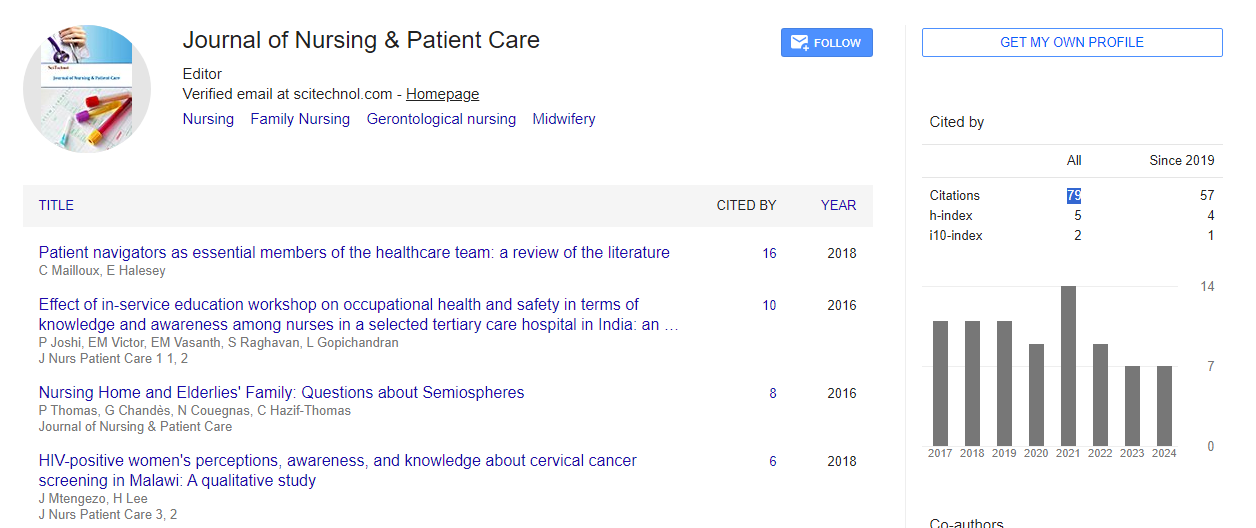Editorial, J Nurs Patient Care Vol: 1 Issue: 2
Statistical Methods in Evaluation of Multidimensional Symptoms in Nursing Research
| Sangchoon Jeon* | |
| Department of Acute Care and Health Systems, Yale School of Nursing, Yale University West Campus, USA | |
| Corresponding author : Sangchoon Jeon Department of Acute Care and Health Systems, Yale School of Nursing, Yale University West Campus, USA Tel:203-785-6280 Fax: 203-737-4480 E-mail: sangchoon.jeon@yale.edu |
|
| Received: April 04, 2016 Accepted: April 06, 2016 Published: April 08, 2016 | |
| Citation: Sangchoon Jeon (2016) Statistical Methods in Evaluation of Multidimensional Symptoms in Nursing Research. J Nurs Patient Care 1:2. doi:10.4172/2573-4571.1000e102 |
Â
Abstract
Since completing advanced degrees in statistics and epidemiology, I have participated in nursing research at Yale School of Nursing (YSN) by providing statistical support for grants. While analyzing data from diverse subjects with cancer, diabetes, sleep disorders, cardiac disease, autism, and other health conditions, I have encountered common statistical problems with inter-correlated multidimensional outcomes in longitudinal observations. One of my primary research interests is to find analytic methods to overcome statistical problems in symptom evaluation.
Keywords: Statistics;Nursing Research
Introduction |
|
| Since completing advanced degrees in statistics and epidemiology, I have participated in nursing research at Yale School of Nursing (YSN) by providing statistical support for grants. While analyzing data from diverse subjects with cancer, diabetes, sleep disorders, cardiac disease, autism, and other health conditions, I have encountered common statistical problems with inter-correlated multidimensional outcomes in longitudinal observations. One of my primary research interests is to find analytic methods to overcome statistical problems in symptom evaluation. | |
| Symptoms are often considered as primary outcomes in nursing research. Patients with chronic disease often suffer from multiple symptoms which could originate from their disease, from side effects of treatment, or from comorbid conditions. Symptoms are important subjective manifestations of disease or health conditions, and symptom burden can be a barrier to treatment adherence. Symptom severity is measured by self-report, which can lead to bias due to different perceptions of symptoms by demographic characteristics and patient experiences. Symptom severity may be affected by which symptoms are rated, other concurrent symptoms, and how the symptoms interfere with daily life. These are often inter-related, and the nature of the inter-relationship may not be physiologically causal. Due to the inter-relationship, symptoms should be assessed simultaneously and covariance of multi-dimensional symptoms should be considered during data analysis. | |
| While participating in a family care research program in cancer, my research focused on how to find critical cut-offs of symptom severity in longitudinal observations, as well as how to handle intercorrelation of multiple symptoms to avoid inflation of type I error from repeated tests with multiple outcomes. We proposed an anchorbased response of symptoms by finding critical cut-offs to maximize differentiation of interference with daily life and functioning due to symptoms [1]. We showed how the cut-offs successfully differentiated interference over multiple courses of chemotherapy [2]. While the identified cut-offs accounted for individual interference levels, we determined how we could reduce bias from difference in perceptions. We applied this analytic strategy to identify a clinically meaningful cut-off in evaluation of tic symptom severity and validated the cutoffs with an unsupervised classification using latent variable analysis [3]. | |
| Our research team also proposed the application of general estimating equation (GEE) and Cox proportional hazard (Cox PH) models with a robust sandwich covariance estimate to account for the inter-correlation among multiple symptoms while evaluating longitudinal response of multiple symptoms [4]. We suggested a novel use of the Cox PH model with time-to-response of symptoms, i.e., time to move from severity above the highest cut-off to below the cut-off, to evaluate symptom improvement. | |
| I have continuously sought alternative statistical methods to account for inter-correlations of multiple symptoms. As multiple symptoms are manifestations of health conditions, we could focus on an unobservable health condition as a latent variable. Instead of handling multiple symptom variables with inter-correlations, I classified patients based on their symptom profiles with a dichotomized or ordinal anchor-based response. Using latent class analysis, we classified cancer patients undergoing chemotherapy into three groups of subjects: those with mild symptoms; those with severe physical symptoms only; and those with severe physical and emotional symptoms. We performed longitudinal evaluations among these groups using latent transitional analysis. These methods allowed us to identify clusters of patients with homogenous symptom profiles without the inter-correlation problem and to examine intervention effects or predictors related to the transitions from one group (severer symptom profile) to the others. | |
| Inter-correlation of symptoms can be more complex than the covariance structures that conventional statistical models can handle. Chronic and acute symptoms may have different covariance structures. Since cross-sectional correlations of some symptoms are merely maintained over time, further research is necessary to understand changes in cross-sectional correlations in longitudinal settings. | |
References |
|
|
Â
 Spanish
Spanish  Chinese
Chinese  Russian
Russian  German
German  French
French  Japanese
Japanese  Portuguese
Portuguese  Hindi
Hindi 